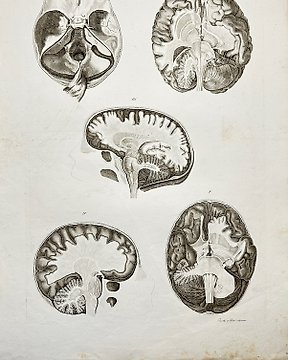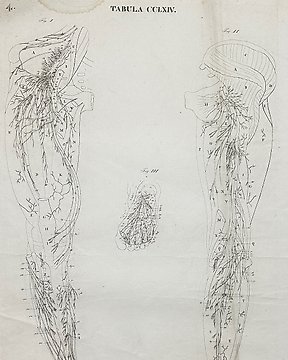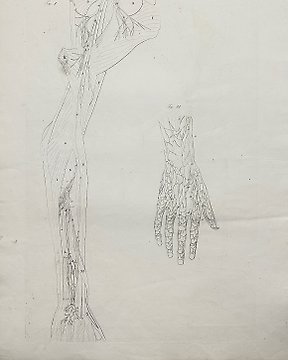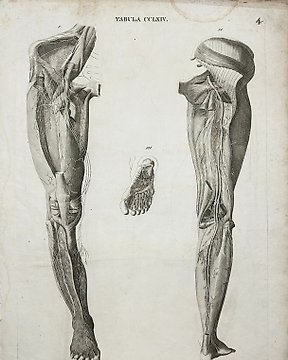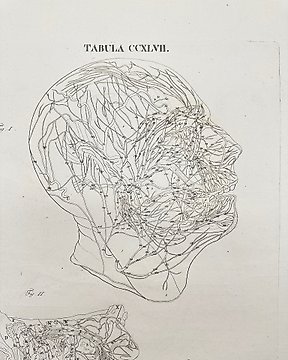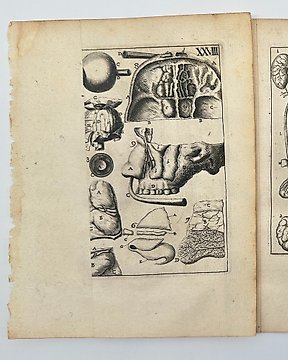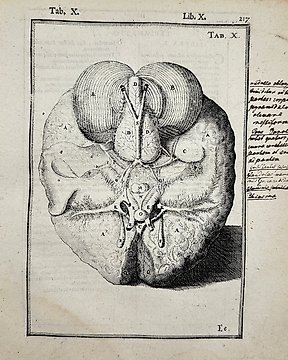Wonderful item perfectly described
查看翻译Domenico Cotugno - De Aquaeductibus auris humane internae dissertatio - 1775
编号 85423243



(Anatomy; Otolaryngology; illustrated) COTUGNO, Domenico.
Dominici Cotunnii Phil. et Med. Doct. De Aquaeductibus auris humane internae dissertatio. Neapoli et Bononiae, ex typographia Sancti Thomae Aquinatis 1775
§ 8vo (210 x 130 ); 116 pag., signature: A-G1-8, Kk1-2; 2 engraved folding plates, woodcut printer’s device on title page, woodcut head- and tail-piece. Contemporary mottled half-calf with corners, spine gilt, marbled edges. Printed exlibris pasted inside front cover. Fine copy on crisp paper. A cornerstone in otolaringology
Domenico Cotugno (1736-1822), one of the most renowned medical scientist of the XVIIIth century, studied medicine at the University of Naples and at the Ospedale degli Incurabili in the same city, institutions to which he devoted most of his life. “Cotugno’s greatest contribution to science resulted from his fusing of anatomy and physiology to uncover the secrets of the human body. ... his anatomical dissertation De aquaeductibus auris humanae internae, following the work of Guichard Joseph Dauverney and Antonio Maria Valsalva and anticipating that of Herman Ludwig von Hamoltz, described the vestibule, semicircular canals, and cochlea of the osseous labyrinth of the internal ear, demonstrated the existence of the labyrinth fluid and formulated a theory of resonance and hearing” (DSB). De aquaeductibus was first published in 1761.
Minieri Riccio p. 110; DSB III, p. 437; Garrison & Morton, 1549 (for the first edition); Norman Library 521 (for the first edition).
(Anatomy; Otolaryngology; illustrated) COTUGNO, Domenico.
Dominici Cotunnii Phil. et Med. Doct. De Aquaeductibus auris humane internae dissertatio. Neapoli et Bononiae, ex typographia Sancti Thomae Aquinatis 1775
§ 8vo (210 x 130 ); 116 pag., signature: A-G1-8, Kk1-2; 2 engraved folding plates, woodcut printer’s device on title page, woodcut head- and tail-piece. Contemporary mottled half-calf with corners, spine gilt, marbled edges. Printed exlibris pasted inside front cover. Fine copy on crisp paper. A cornerstone in otolaringology
Domenico Cotugno (1736-1822), one of the most renowned medical scientist of the XVIIIth century, studied medicine at the University of Naples and at the Ospedale degli Incurabili in the same city, institutions to which he devoted most of his life. “Cotugno’s greatest contribution to science resulted from his fusing of anatomy and physiology to uncover the secrets of the human body. ... his anatomical dissertation De aquaeductibus auris humanae internae, following the work of Guichard Joseph Dauverney and Antonio Maria Valsalva and anticipating that of Herman Ludwig von Hamoltz, described the vestibule, semicircular canals, and cochlea of the osseous labyrinth of the internal ear, demonstrated the existence of the labyrinth fluid and formulated a theory of resonance and hearing” (DSB). De aquaeductibus was first published in 1761.
Minieri Riccio p. 110; DSB III, p. 437; Garrison & Morton, 1549 (for the first edition); Norman Library 521 (for the first edition).

